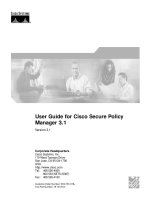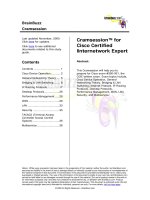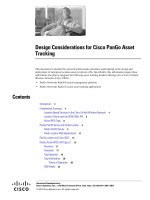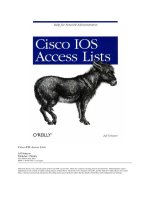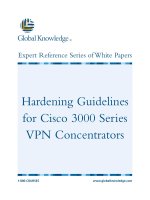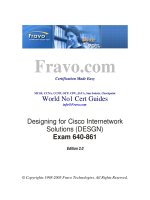tcl scripting for cisco ios
Bạn đang xem bản rút gọn của tài liệu. Xem và tải ngay bản đầy đủ của tài liệu tại đây (2.8 MB, 311 trang )
www.it-ebooks.info
Tcl Scripting for Cisco IOS
Ray Blair, CCIE No. 7050
Arvind Durai, CCIE No. 7016
John Lautmann
Cisco Press
800 East 96th Street
Indianapolis, IN 46240
www.it-ebooks.info
ii Tcl Scripting for Cisco IOS
Tcl Scripting for Cisco IOS
Ray Blair, Arvind Durai, John Lautmann
Copyright © 2010 Cisco Systems, Inc.
Published by:
Cisco Press
800 East 96th Street
Indianapolis, IN 46240 USA
All rights reserved. No part of this book may be reproduced or transmitted in any form or by any means,
electronic or mechanical, including photocopying, recording, or by any information storage and retrieval sys-
tem, without written permission from the publisher, except for the inclusion of brief quotations in a review.
Printed in the United States of America
First Printing June 2010
Library of Congress Cataloging-in-Publication Data:
Blair, Ray, 1965—
Tcl scripting for Cisco IOS / Ray Blair, Arvind Durai, John Lautmann.
p. cm.
ISBN-13: 978-1-58705-945-2 (pbk.)
ISBN-10: 1-58705-945-2 (pbk.)
1. Tcl (Computer program language) 2. Cisco IOS. I. Durai, Arvind.
II. Lautmann, John. III. Title.
QA76.73.T44B58 2010
005.13'3—dc22
2010015179
ISBN-13: 978-1-58705-945-2
ISBN-10: 1-58705-945-2
Warning and Disclaimer
This book is designed to provide information about the Tcl scripting for Cisco IOS Software. Every effort has
been made to make this book as complete and as accurate as possible, but no warranty or fitness is implied.
The information is provided on an “as is” basis. The authors, Cisco Press, and Cisco Systems, Inc. shall have
neither liability nor responsibility to any person or entity with respect to any loss or damages arising from
the information contained in this book or from the use of the discs or programs that may accompany it.
The opinions expressed in this book belong to the author and are not necessarily those of Cisco Systems, Inc.
Trademark Acknowledgments
All terms mentioned in this book that are known to be trademarks or service marks have been appropriate-
ly capitalized. Cisco Press or Cisco Systems, Inc., cannot attest to the accuracy of this information. Use of
a term in this book should not be regarded as affecting the validity of any trademark or service mark.
www.it-ebooks.info
iii
Corporate and Government Sales
The publisher offers excellent discounts on this book when ordered in quantity for bulk purchases or spe-
cial sales, which may include electronic versions and/or custom covers and content particular to your busi-
ness, training goals, marketing focus, and branding interests. For more information, please contact: U.S.
Corporate and Government Sales 1-800-382-3419
For sales outside the United States, please contact: International Sales
Feedback Information
At Cisco Press, our goal is to create in-depth technical books of the highest quality and value. Each book
is crafted with care and precision, undergoing rigorous development that involves the unique expertise of
members from the professional technical community.
Readers’ feedback is a natural continuation of this process. If you have any comments regarding how we
could improve the quality of this book, or otherwise alter it to better suit your needs, you can contact us
through e-mail at Please make sure to include the book title and ISBN in your
message.
We greatly appreciate your assistance.
Publisher: Paul Boger Cisco Representative: Eric Ullanderson
Associate Publisher: Dave Dusthimer Cisco Press Program Manager: Anand Sundaram
Executive Editor: Brett Bartow Copy Editor: Keith Cline
Managing Editor: Sandra Schroeder Proofreader: Sheri Cain
Senior Development Editor: Christopher Cleveland Technical Editors:
Joe Marcus Clarke, Greg S. Thompson
Project Editor: Mandie Frank
Editorial Assistant: Vanessa Evans Book Designer: Louisa Adair
Cover Designer: Sandra Schroeder Composition: Mark Shirar
Indexer: Tim Wright
Cisco has more than 200 offices worldwide. Addresses, phone numbers, and fax numbers are listed on the Cisco Website at www.cisco.com/go/offices.
CCDE, CCENT, Cisco Eos, Cisco HealthPresence, the Cisco logo, Cisco Lumin, Cisco Nexus, Cisco StadiumVision, Cisco TelePresence, Cisco WebEx, DCE, and Welcome to the Human Network are trademarks; Changing the
Way We Work, Live, Play, and Learn and Cisco Store are service marks; and Access Registrar, Aironet, AsyncOS, Bringing the Meeting To You, Catalyst, CCDA, CCDP, CCIE, CCIP, CCNA, CCNP, CCSP, CCVP, Cisco, the
Cisco Certified Internetwork Expert logo, Cisco IOS, Cisco Press, Cisco Systems, Cisco Systems Capital, the Cisco Systems logo, Cisco Unity, Collaboration Without Limitation, EtherFast, EtherSwitch, Event Center, Fast Step,
Follow Me Browsing, FormShare, GigaDrive, HomeLink, Internet Quotient, IOS, iPhone, iQuick Study, IronPort, the IronPort logo, LightStream, Linksys, MediaTone, MeetingPlace, MeetingPlace Chime Sound, MGX, Networkers,
Networking Academy, Network Registrar, PCNow, PIX, PowerPanels, ProConnect, ScriptShare, SenderBase, SMARTnet, Spectrum Expert, StackWise, The Fastest Way to Increase Your Internet Quotient, TransPath, WebEx, and
the WebEx logo are registered trademarks of Cisco Systems, Inc. and/or its affiliates in the United States and certain other countries.
All other trademarks mentioned in this document or website are the property of their respective owners. The use of the word partner does not imply a partnership relationship between Cisco and any other company. (0812R)
Americas Headquarters
Cisco Systems, Inc.
San Jose, CA
Asia Pacific Headquarters
Cisco Systems (USA) Pte. Ltd.
Singapore
Europe Headquarters
Cisco Systems International BV
Amsterdam, The Netherlands
www.it-ebooks.info
About the Authors
Ray Blair, CCIE No. 7050, is a Vertical Solutions Architect and has been with Cisco
Systems for more than 10 years, working primarily with large network designs. He has
almost 22 years of experience with designing, implementing, and maintaining networks
that have included nearly all networking technologies. During the early stages of his
career, he wrote many applications using Assembly language and C. Mr. Blair maintains
three CCIE certifications in Routing and Switching, Security, and Service Provider. He is
also a Certified Information Systems Security Professional (CISSP) and coauthor of the
Cisco Secure Firewall Services Module book.
Arvind Durai, CCIE No. 7016, is an Advanced Services Technical Leader for Cisco
Systems. His primary responsibility in the past 10 years has been in supporting major
Cisco customers in the enterprise sector, including financial, manufacturing, e-commerce,
state government, utility (smart grid networks) and health-care sectors. Some of his
focuses have been on security, multicast, network virtualization, and he has authored sev-
eral white papers and design guides in various technologies. He has leveraged Embedded
Event Manager (EEM) and Tool Command Language (Tcl) scripts in various customer
designs. Mr. Durai maintains two CCIE certifications: Routing and Switching, and
Security. He holds a Bachelor of Science degree in electronics and communication, a
master’s degree in electrical engineering (MS), and master’s degree in business administra-
tion (MBA), and is a coauthor of Cisco Secure Firewall Services Module.
John Lautmann is a Software Engineer for Cisco Systems. He has developed and
enhanced network management software for nearly 14 years. Before joining Cisco, he
held positions in customer support and software testing. With six networking patents,
John has been involved in the development of new Cisco IOS features such as data-link
switching, syslog, configuration rollback and archiving, IOS Tcl interpreter, digitally
signed Tcl scripts, and Multiprotocol Label Switching (MPLS) ping and trace. Mr.
Lautmann holds a Bachelor of Science degree in computer science and master’s degrees in
both business and engineering.
iv Tcl Scripting for Cisco IOS
www.it-ebooks.info
About the Technical Reviewers
Joe Marcus Clarke, CCIE No. 5384, is a distinguished support engineer working in
Technical Services and specializing in network management. In his 11+ years at Cisco, he
has handled worldwide escalations for network management problems relating to SNMP,
CiscoWorks, and embedded management technologies. He has also helped customers
design and implement embedded management solutions using the Embedded Event
Manager, Embedded Syslog Manager, and the Tcl shell in IOS. He works closely with the
embedded management technology teams to improve and extend the capabilities in Cisco
products. Joe is also extremely active on the Cisco Support Communities (aka NetPro)
network management forum where he provides assistance to customers on a wide variety
of network management issues.
Greg S. Thompson is a senior software engineer with more than 25 years of experience
working in networking/telecommunications. He has spent the past several years at Cisco
Systems, Inc. implementing Tcl and Tcl-based features in Cisco IOS, such as ESM
(Embedded Syslog Manager) and EMM (Embedded Menu Manager).
Dedications
Ray Blair As with everything in my life, I thank my Lord and Savior for his faithful
leading that has brought me to this place. This book is dedicated to my wife, Sonya, and
my children, Sam, Riley, Sophie, and Regan. You guys mean the world to me!
Arvind Durai This book is dedicated to my wife, Monica, and my son, Akhhill. Thank
you for everything!
To my parents, for providing me with values.
To my brother and family, my parents-in-law, and brother-in-law and family for all their
good wishes.
Thank you, God!
John Lautmann I dedicate this book to my family: my wife, Susana, my daughter, Kate,
and my son, Rhys. You are all very special!
v
www.it-ebooks.info
Acknowledgments
Ray Blair This project was a significant undertaking, and without the partnership of
Arvind and John, and the support of those mentioned here and many others, this would
not have been an achievable goal. I am very grateful for all your help and support in com-
pleting this book!
Thanks to my wife, Sonya, and my children, Sam, Riley, Sophie, and Regan, for your
patience in the many hours I spent working on this book.
Arvind and John, your excellent technical knowledge and dedication to the accuracy of
the content made writing this book a pleasure. I look forward to many more years as your
colleague and friend.
Arvind Durai Thanks to my wife, Monica, and my son, Akhhill, for your support and
tolerance with my long working hours.
Thanks to my director, Andrew Maximow, and my manager, Shibu Nair, for supporting
me in this effort.
As always, it is great working with Ray and John, who have immaculate technical knowl-
edge and dedication. You both have made the experience of writing this book a pleasure.
Thank you!
John Lautmann I would like to thank my family members for their support during the
writing of this book. I could not have done it without you. Thank you Susana, Kate,
Rhys, Judith, and Ron.
Thank you Arvind and Ray for your excellent support and motivation during the writing
of the book. As a team, we can achieve anything!
Our special thanks to:
We are very grateful to Joe Marcus Clarke and Greg S. Thompson for their valuable input
in providing direction and maintaining accuracy of the material in this book. Without the
talent of these two technical reviewers, the book would not have been possible.
The Cisco Press team was very helpful in providing excellent feedback and direction,
many thanks to Brett Bartow, Christopher Cleveland, and Dayna Isley.
Thanks to all of our customers with whom we have worked. Each customer scenario
inspired us to write this book.
vi Tcl Scripting for Cisco IOS
www.it-ebooks.info
Contents at a Glance
Introduction xiv
Chapter 1 The Origin of Tcl 1
Chapter 2 Tcl Interpreter and Language Basics 11
Chapter 3 Tcl Functioning in Cisco IOS 33
Chapter 4 Embedded Event Manager (EEM) 55
Chapter 5 Advanced Tcl Operation in Cisco IOS 111
Chapter 6 Tcl Script Examples 183
Chapter 7 Security in Tcl Scripts 243
Appendix A Cisco IOS Tcl Commands Quick Reference 259
Index 287
vii
www.it-ebooks.info
viii Tcl Scripting for Cisco IOS
Contents
Introduction xiv
Chapter 1 The Origin of Tcl 1
Tcl and Cisco IOS Software 3
Embedded Event Manager and Tcl 4
Restriction of Tcl in IOS 4
Tcl with EEM Support in IOS 5
Using Tcl Scripts in the Network 8
Troubleshooting Problems 8
Monitoring the Network 8
Adding Intelligence to Cisco IOS Protocols 9
Summary 9
References 9
Chapter 2 Tcl Interpreter and Language Basics 11
Simple Variables in Tcl 12
Storing Variables 12
Viewing Variables 13
The append Command 13
The incr Command 13
Representation of Variables in Tcl 14
Command Substitution 14
Variable Substitution 15
Lists 17
lappend 18
lindex 18
linsert 18
llength 19
lsearch 19
lreplace 20
lrange 20
lsort 20
Procedures 21
for Command 22
foreach Command 23
while Command 23
www.it-ebooks.info
Arrays 24
if Command 26
switch Command 27
Files 28
Summary 31
References 31
Chapter 3 Tcl Functioning in Cisco IOS 33
Understanding the Tcl Interpreter in Cisco IOS 33
Using Cisco IOS Exec-Mode Parser in the Tcl Shell 34
Entering an IOS Command into the Tcl Command Interpreter 35
Using Tcl to Enter Commands 36
Copying a Tcl Script to a Cisco IOS Device 38
Fetching a Cisco IOS Tcl Script from a Remote Device 41
Using Tcl to Examine the Cisco IOS Device Configuration 41
Using Tcl to Modify the Router Configuration 43
Using Tcl with SNMP to Check MIB Variables 44
Other Uses of SNMP 44
Enabling SNMP on a Cisco IOS Device 47
Querying the Configuration of a Cisco IOS Device Using SNMP 48
Modifying the Configuration of a Cisco IOS Device Using SNMP 51
Summary 53
References 53
Chapter 4 Embedded Event Manager (EEM) 55
EEM Architecture 55
Policies 56
EEM Server 56
Event Detectors 57
Software Release Support for EEM 60
Platform and IOS Considerations for EEM 65
Writing an EEM Applet 66
Practical Example of an Event Trigger 68
Using Object Tracking as an Event Trigger 69
Creating Applet Actions 70
Examples of EEM Applets 70
Configuring the IP SLA Sender and Responder 72
Applet and IP SLA Route Failover Example 74
ix
www.it-ebooks.info
Applet That Monitors the Default Route 83
Applet and Application Failover with a Network Address Translation
Example 88
Using EEM and Tcl Scripts 96
Programming Policies with Tcl 97
Tcl Example Used to Check for Interface Errors 98
Tcl Example Used to Check the CPU Utilization 104
Summary 110
References 110
Chapter 5 Advanced Tcl Operation in Cisco IOS 111
Introduction to the Syslog Protocol 112
Configuring Syslog Server Parameters in Cisco IOS 113
Syslog Tcl Script Example 116
Syslog Tcl Script Sample Output 118
Sending Syslog Messages to a File 121
Syslog Server Script Procedures 124
Syslog Server Script Body 127
Putting the Syslog Script into Operation 129
Introduction to Embedded Syslog Manager 130
Filtering Syslog Messages 130
ESM Global Variables 134
Rebuilding a Syslog Message from Its Components 136
Displaying/Adding ESM Tcl Script Filters 137
Introduction to Embedded Menu Manager 139
Using Tcl as a Web Server 144
Obtaining a Free Web Server Application 147
Reverse Engineering the Web Server 149
Creating Your Own Simple Web Page 152
Creating a Web Page Using IOS show Commands 154
Adding User Input to the Web Page 157
Introduction to IP SLA 160
Adding the IP SLA Measurement to the Web Page 162
Modifying the Button and Label for User Input 162
Creating a Tcl Script to Display IP SLA Measurement Results 163
Putting the New Tcl Scripts into Operation 165
Reformatting the IP SLA Output for Readability 167
x Tcl Scripting for Cisco IOS
www.it-ebooks.info
Automatic Removal and Creation of IP SLA Entries 170
Displaying the Results of the IP SLA Measurement
with Auto-Refresh 174
Tcl Script Refresh Policy 177
SNMP Proxy Event Detector 178
Remote-Procedure Call Requests 179
Multiple-Event Support for Event Correlation 180
Using the clear Command 181
Summary 182
References 182
Chapter 6 Tcl Script Examples 183
Creating an Application from Start to Finish 183
Determine What You Want to Accomplish 183
Creating a Flowchart 184
Deciding What the User Interface Should Look Like 185
Write the Code in Pseudo-Code 187
Before You Begin 188
Starting to Program the Application 190
Configuring the Web Server 190
Writing Code for the MPLS VPN Script 191
Configuring HTML 209
Writing Code for the MPLS CFG Script 216
Troubleshooting as You Go 228
Using Tcl to Troubleshoot Network Problems 230
Monitoring the Console for Events 233
Creating a Web Application for Remote SNMP Graphing 236
Summary 241
References 241
Chapter 7 Security in Tcl Scripts 243
Introduction to PKI Infrastructure 243
PKI Prerequisite 244
Confidentiality with PKI 244
Digital Signatures with PKI 245
Using Digital Signatures to Sign a Tcl Script 247
Step 1: Decide on the Final Tcl Script Contents (Myscript) 248
Step 2: Generate a Public/Private Key Pair 248
xi
www.it-ebooks.info
Step 3: Generate a Certificate with the Key Pair 250
Step 4: Generate a Detached S/MIME pkcs7 Signature
for Myscript Using the Private Key 250
Step 5: Modify the Format of the Signature to Match
the Cisco Style for Signed Tcl Scripts and Append
It to the End of Myscript 251
Tcl Script-Failure Scenario 256
Scaling Tcl Script Distribution 257
Summary 258
References 258
Appendix A Cisco IOS Tcl Commands Quick Reference 259
Index 287
xii Tcl Scripting for Cisco IOS
www.it-ebooks.info
Command Syntax Conventions
The conventions used to present command syntax in this book are the same conventions
used in the IOS Command Reference. The Command Reference describes these conven-
tions as follows:
■ Boldface indicates commands and keywords that are entered literally as shown. In
actual configuration examples and output (not general command syntax), boldface
indicates commands that are manually input by the user (such as a show command).
■ Italic indicates arguments for which you supply actual values.
■ Vertical bars (|) separate alternative, mutually exclusive elements.
■ Square brackets ([ ]) indicate an optional element.
■ Braces ({ }) indicate a required choice.
■ Braces within brackets ([{ }]) indicate a required choice within an optional element.
xiii
www.it-ebooks.info
Introduction
Embedded Event Manager (EEM) along with Tool Command Language (Tcl) and applets
enable you to customize the operation of the IOS device. These powerful tools can be
leveraged when the normal operation of IOS is not suitable for your specific requirements.
This book was written to provide an understanding of the operation of EEM, Tcl, and
applets. It begins with the fundamentals of Tcl and provides practical examples of how to
create your own application.
Who Should Read This Book?
This book is targeted at individuals who manage, maintain, or operate a network that con-
tains IOS devices. To get the most value from the material, you should have at least a
basic knowledge of programming.
How This Book Is Organized
This book is organized into seven chapters and one appendix and includes an introduc-
tion to Tcl, language basics, Cisco IOS device support, how Tcl functions in IOS, the use
of EEM, and practical examples. After absorbing the material in this book, you will be
well qualified to write your own programs. The chapters in this book cover the following
topics:
■ Chapter 1, “The Origin of Tcl”: This chapter introduces Tcl, EEM, and how you can
use them to enhance Cisco IOS.
■ Chapter 2, “Tcl Interpreter and Language Basics”: This chapter provides an
overview of the basic command syntax for Tcl.
■ Chapter 3, “Tcl Functioning in Cisco IOS”: This chapter examines how Tcl functions
in Cisco IOS.
■ Chapter 4, “Embedded Event Manager (EEM)”: This chapter explains the various
EEM versions, platform considerations, and applets.
■ Chapter 5, “Advanced Tcl Operation in Cisco IOS”: This chapter covers Embedded
Syslog Manger (ESM), Embedded Menu Manager (EMM), and includes myriad Tcl
examples.
■ Chapter 6, “Tcl Script Examples”: This chapter explains how to write a Tcl script
from start to finish.
■ Chapter 7, “Security in Tcl Scripts”: This chapter introduces public key infrastruc-
ture (PKI) and covers how to secure Tcl scripts.
■ Appendix A, “Cisco IOS Tcl Commands Quick Reference”: This appendix covers
Tcl commands specific to Cisco IOS.
xiv Tcl Scripting for Cisco IOS
www.it-ebooks.info
TCL Scripting Examples
To register this product and gain access to sample Tcl scripts, go to www.ciscopress.
com/tclscripting to sign in and enter the ISBN. After you register the book, a link to the
bonus content will be listed on your Account page, under Registered Products.
Chapter 3:
■ chap3e1.tcl—Verifies if the 10.0.0.x network is associated with any local
interfaces.
■ chap3e2.tcl—Parses the running-configuration and looks for and displays the time-
zone parameter. This script is helpful to parse parameters or text from the Cisco CLI
show command and derive the desired value as an output.
Chapter 4:
■ cpu_threshold_email.tcl—Sends an email in the event the CPU utilization is over
60%.
■ interface_errors_email.tcl—Sends an email in the event interface errors are detected.
Chapter 5:
■ syslogd_book.tcl—This is a syslog daemon script application that displays the
syslog messages at the terminal.
■ syslogd_book2.tcl—This is a syslog daemon script application used to collect and
store information locally on an IOS device. There are two input parameters: tcp port
and file name to write syslog messages.
■ filter.tcl, filter2.tcl, filter3.tcl, filter4.tcl—Performs embedded syslog manager
message processing.
■ my.mdf , my2.mdf, my3.mdf—Examples of Embedded Menu Manager menu
definition files.
■ chap5e1.tcl, chap5e2.tcl, chap5e3.tcl, chap5e4.tcl, clock.tcl, ipsla.tcl, ipsla1.tcl,
ipsla1.5.tcl, ipsla2.tcl, ipsla3.tcl, ipslaresult1.tcl—Examples of Tcl scripts that
generate web pages.
Chapter 6:
■ MPLS-VPN.tcl—This provisions MPLS VPN on a router through a GUI. (This appli-
cation was tested on an ISR2800.)
■ Remote-SNMP.tcl—Collects SNMP data from a remote device and displays it to the
user as a graph on web page.
xv
www.it-ebooks.info
Chapter 7:
■ my_append—An expect script that assists in converting and generating the correct
format for signed Tcl script.
■ myscript—Raw Tcl script to be signed.
■ myscript.hex, myscript.hex_sig, myscript.pk7—Intermediate files generated in the
process of signing a Tcl script.
■ myscript.tcl—The final signed Tcl script in the correct format.
■ myscript-changed1char.tcl—The final signed Tcl script with one modified character
to illustrate the security violation being detected.
Appendix A:
■ arg-demo.tcl—Illustrates the use of input arguments to a Tcl script.
■ count-to-one.tcl—A Tcl script that counts to 1.
■ count-to-ten.tbc—A Tcl script that counts to 10, in byte-code format.
■ count-to-ten.tcl—A Tcl script that counts to 10.
■ debugging-tcl_trace—Example procedures used to understand debugging using
tcl_trace.
■ int.tcl—A Tcl script the prints the value of tcl_interactive.
■ mypackages/—directory.
■ pkgIndex.tcl—File that assists in loading the correct package when a Tcl script
requires a package.
■ circle.tcl, square.tcl, triangle.tcl—Tcl files that provide some example packages.
xvi Tcl Scripting for Cisco IOS
www.it-ebooks.info
Chapter 1
The Origin of Tcl
This chapter covers the following topics:
■ Tcl and Cisco IOS Software
■ Using Tcl Scripts in the Network
Tool Command Language (Tcl), invented in the late 1980s by John K. Ousterhout of the
University of California, Berkeley, is a dynamic programming or scripting language, an
interpreter, and a C library. Tcl helps users control other applications or utilities using
basic flow control. Tcl is pronounced “tickle” or “tee-cee-ell.” One of the original sugges-
tions for a title of this book was How to Tickle Your Router, which, although inappropri-
ate, is quite descriptive.
Tcl is an interpreted programming language versus a compiled programming language.
One advantage of an interpreted language is speed in the development process. A pro-
grammer can make changes quickly as the script is being developed and rapidly run the
script to see the changes. Another advantage is that the script is available for any users to
modify because it is written in a plain text format, with the exception of precompiled
byte-code. As the requirements change over time, various changes can easily be made to
modify the script to suit customer needs.
Note Precompiled byte-code enables you to hide the implementation details of a TCL
script and is discussed in greater detail in Chapter 7, “Security in Tcl Scripts.”
www.it-ebooks.info
2 Tcl Scripting for Cisco IOS
The disadvantage of an interpreted programming language is performance. The speed of
execution is reduced slightly because of the overhead of interpreting the script com-
mands first. The execution speed depends on the operating system, processor, program-
ming language, and so on, but will typically be in the range of a few seconds. At runtime,
the Tcl script must first be parsed before execution can begin. In contrast, a compiled
language is written and compiled ahead of time. At runtime, the machine language (com-
piled code) is run without the interpretation step. Another disadvantage for commercial
applications is the difficulty hiding the contents of the script. Because the script is plain
text, a software company will be reluctant to release their work in an open format that
can be seen and copied. The code can be obfuscated through the process of byte-code
compilation, but this is not a completely secure method, because compiled byte-code
can be reverse-engineered. This also makes it difficult to protect the intellectual property
rights of the software they develop.
Besides performance, the memory requirements are generally greater for an interpreted
language because the entire contents of the script itself, the compiled version of the
script, and all the script variables are held in memory. Do not allow this to discourage
you from writing Tcl scripts, however; they still are very usable and have a relatively small
memory footprint.
Key benefits of Tcl include the following:
■ Used to manipulate and display information that can be obtained from other devices,
a user interface, a database, and so on.
■ The automation of complex tasks.
■ There are many commands for the manipulation of information, including integers
and strings.
■ Simple language to learn.
Another component of Tcl is Tool Kit (Tk). Tk is a library of procedures written to create
graphical user interfaces (GUI). Tk includes commands to create GUI widgets, windows,
buttons, text boxes, and so on. Tk also provides a GUI for the host operating system
where the script is executed. Tk is not covered in this book because Tk support is not
available in Cisco IOS Software.
The usage of Tcl can be seen in the following areas:
■ Testing and automation: Use of this language is commonly seen in testing environ-
ments to leverage the capability of the language to interact with various software and
hardware devices.
■ Web applications: Tcl has Tcllib libraries, including a number of Common Gateway
Interface (CGI) libraries and can also be used as a conventional web programming
language.
www.it-ebooks.info
Chapter 1: The Origin of Tcl 3
■ Desktop GUI applications: With the help of Tk, Tcl has been used to write GUI
applications. The dynamic approach of Tcl makes it easy to develop GUIs.
■ Databases: Tcl extensions are available to use for all standard databases, such as
Oracle, Sybase, and so on.
■ Embedded development: Tcl is a compact language and is popular with embedded
development. Tcl scripts are hidden in many hardware devices for user-defined func-
tionality.
Tcl/Tk has been gaining popularity and interest among users from the time it was intro-
duced. This is primarily because it is fast, powerful, easy to learn, and can run on almost
all computing platforms. The Tcl language is different from many other scripting lan-
guages in that it can embed into other applications. These applications can easily add a
full-feature Tcl interpreter and macro language.
Note Another offshoot of Tcl is Expect. Expect is highly specialized to match output
strings. The primary use of Expect is to automate interactive user sessions such as Telnet,
Secure Shell (SSH), File Transfer Protocol (FTP), Secure FTP (SFTP), and so on. For addi-
tional information about Expect, refer to Exploring Expect, by Don Libes (O’Reilly, 1994;
ISBN 1-56592-090-2).
Tcl and Cisco IOS Software
By now, you probably have a general understanding of Tcl, but you may be thinking,
“What’s it gonna do for me?” The combination of Tcl with Cisco IOS Software is a pow-
erful tool, one that enables you to enhance the operation of Cisco IOS. With the addition
of Tcl, you can customize IOS to execute unique procedures specific to your environ-
ment. Maybe you would like to create a menu for the help desk to make VLAN changes
on defined ports, but disallow any other changes. Are you thinking of other applications?
If you are considering running Tcl, you might also be wondering what devices are sup-
ported. The Tcl shell was first introduced in 12.3(2)T and 12.2(25)S and was merged into
the Catalyst 6500 in version 12.2.(18)SX4 for modular IOS and 12.2(18)SX5 for IOS. In
the desktop switching space, Tcl shell was added in 12.2(40)SE.
Note If you do not have access to a router or switch that supports Tcl, you can start prac-
ticing on your computer. Windows, Mac OS X, and UNIX operating systems all support
Tcl. You can download and install/compile Tcl to run on your computer. You can access the
official Tcl/Tk distribution site at />This is probably a better place to start, rather than practicing on production equipment,
especially if you want to keep your job!
www.it-ebooks.info
4 Tcl Scripting for Cisco IOS
Embedded Event Manager and Tcl
Embedded Event Manager (EEM) is a powerful tool available in Cisco IOS Software that
enables users to run Tcl programs/scripts or applets directly on Cisco routers or switches.
An applet is a single or series of IOS commands, similar to a macro. The support for EEM
helps users to manage Cisco devices through event detectors. Event detectors monitor
both the hardware and software components on specific platforms.
Examples of EEM functionality include the following:
■ Event detectors monitor specific conditions of the device, and based on those param-
eters, event triggers can initiate a script to perform a predefined task.
■ EEM can take actions based on syslog messages. For example, after detecting a
CPUhog syslog message, EEM could take particular show command output and
send an e-mail to the user.
■ EEM can be used to influence the route forwarding based on an IOS trigger.
EEM has the capability to trigger or initiate two unique functions:
■ Create applet policies: This is an easy-to-use interface using IOS command-line inter-
face (CLI) commands. The user does not need to know the details of a scripting lan-
guage; the familiarity with IOS is sufficient to create an applet policy.
■ Write user-defined policies with Tcl scripts: This is more flexible because it is not
constrained by IOS commands only and has extensive capabilities; however, the user
should know how to use the Tcl language.
Note Chapter 4, “Embedded Event Manager (EEM),” covers EEM in more detail.
Figure 1-1 offers a graphical example of the relationship of event detectors, EEM, Tcl
scripts, and applets.
Restriction of Tcl in IOS
Before getting into the details of writing Tcl scripts, you should be familiar with Tcl pro-
gramming and Cisco IOS commands.
Tcl code can be executed from the Tcl parser shell mode in the Cisco IOS CLI. The exe-
cution of Tcl in the CLI can be done only from privileged EXEC mode.
For example:
R1>en
Password:
R1#tclsh
R1(Tcl)#
www.it-ebooks.info
Chapter 1: The Origin of Tcl 5
Event Detectors
Watch for Events of Interest
EEM Server
Brains of the System
Policies
Actions to Take
(Tcl Script or Applet)
IOS Subsystems
Subscribes to receive
application events,
publishes application
events using
Application Specific
Event Detector
EEM Applet Policy
Subscribes to receive
events, implements
policy actions
EEM Tcl Policy
Subscribes to receive
events, implements
policy actions
Tcl Shell
Application
Specific
Event Detector
“None”
Event Detector
EEM Server
Command
Line Interface
Timer
Services
Counters Syslog OIR
Interface
Counters &
Status
Embedded
Resource
Manager
Posix
Process
Manager
IOS Process
Watchdog
SNMP
Generic Online
Diagnostics
(GOLD)
Redundancy
Facility
Object Tracking
Cisco IOS Infrastructure and Network Subsystems
Event
Detectors
Figure 1-1 EEM’s Relationship with Other Functions
Certain functionality of Cisco IOS uses Tcl subsystems such as Embedded Syslog
Manager (ESM), Embedded Menu Manager (EMM), and Interactive Voice Response
(IVR). These topics are covered in greater detail in Chapter 5, “Advanced Tcl Operation in
Cisco IOS.” These subsystems integrate proprietary commands and keywords not avail-
able in a Tcl shell.
A Tcl shell can be enabled, and Tcl commands can be executed, in IOS. The Tcl interpreter
checks whether the entered Tcl commands are valid, and if so, the result is sent to the tty.
Tcl commands that are not recognized as valid are sent to the Cisco IOS CLI parser.
Tcl with EEM Support in IOS
Tcl commands from version 8.3.4 are available in Cisco IOS. Table 1-1 shows support for
Tcl with EEM in specific Cisco IOS code versions.
www.it-ebooks.info
6 Tcl Scripting for Cisco IOS
Platform IOS Release (Beginning With)
10000-PRE2 12.2(28)SB
10000-PRE3 12.2(31)SB2
10000-PRE4 12.2(33)SB
1700 series 12.3(14)T1
1800 series 12.3(14)YT
2600XM 12.3(14)T1
2691 12.3(14)T1
2800 series 12.3(14)T
3270 12.4(24)T
3600 series 12.3(14)T1
3700 series 12.3(14)T1
3800 series 12.3(14)T1
7200 12.2(25)S
7200-NPE-G2 12.2(31)SB2
7201 12.2(31)SB5
7301 12.2(31)SB3
7500 12.2(25)S
7600-RSP720-10GE 12.2(33)SRC
7600-RSP720/MSFC4 12.2(33)SRB
7600-SAMI 12.2(33)SRD
800 series 12.4(6)XE3
AS5350XM 12.4(20)T
AS5400XM 12.4(20)T
ASR1000-RP1 2.1.0
ASR1000-RP2 2.3.0
Cat 6500-Sup720 12.2(33)SXH
CAT3560E 12.2(35)SE1
CAT3750E 12.2(35)SE1
Table 1-1 Tcl with EEM Support by Cisco Device/IOS Release
www.it-ebooks.info
Chapter 1: The Origin of Tcl 7
Platform IOS Release (Beginning With)
CAT3750Metro 12.2(40)SE
CAT4500E-SUP6E 12.2(50)SG
CAT4948 12.2(44)SG
CAT4948-10GE 12.2(44)SG
CAT6000-SUP32/MSFC2A 12.2(33)SXH
CAT6000-VS-S720-10G/MSFC3 12.2(33)SXH
CBS3000 series 12.2(40)EX2
CBS3100 series 12.2(40)EX2
CRS-1 3.5.4
IAD2400 series 12.4(22)T
IAD2801 12.4(11)XJ2
IAD880 series 12.4(20)T
ME3400 12.2(40)SE
ME3400E 12.2(44)EY
ME4900 12.2(40)SG
ME6524 12.2(33)SXH
UBR10K-PRE2 12.2(33)SCB2
UBR10K-PRE4 12.2(33)SCB2
UBR7200 12.2(33)SCB2
UBR7200-NPE-G2 12.2(33)SCB2
UC520 12.4(20)T1
VGD-1T3 12.4(22)T
XR 12000-PRP 3.5.4
Nexus 7000
*
Applets only
*Applets are covered in Chapter 4. This is not a comprehensive list. Consult the documentation
on your specific device and version requirements.
www.it-ebooks.info
8 Tcl Scripting for Cisco IOS
Using Tcl Scripts in the Network
Network administrators can leverage Tcl scripts to provide enhanced functionality. Scripts
can be used for troubleshooting, monitoring, and increasing the intelligence of IOS, as
described in the sections that follow.
Troubleshooting Problems
Network administrators use different methods to analyze and troubleshoot problems in
the network. Some of these tools and technologies consist of packet-capture devices or
sniffers, Remote Monitoring (RMON) probes, NetFlow collectors, Simple Network
Management Protocol (SNMP), IP service level agreement (IP SLA) measurements, net-
work management system (NMS) tools, and so on. These tools help in gathering informa-
tion about the condition or health of the network. Collection of information is accom-
plished through the monitoring or analysis of the packet passing to or through an inter-
face. The problems that are more difficult to detect are those that do not break the net-
work or node and are often referred to as silent drops. Some of the examples of silent
drops are as follows:
■ Packets dropped because of an incorrect quality of service (QoS) implementation
■ Application slowness in the network
■ High CPU usage
■ Faulty cable infrastructure
Tcl scripts can be used to collect information based on an event. For example, if drops in
the QoS queue or drops on the interfaces increase, a script can be executed to collect the
interface statistic and send an e-mail with the pertinent information. You might find your-
self troubleshooting an issue that occurs infrequently, in which case, the capability to
execute a script to collect relevant information might just prove invaluable.
Monitoring the Network
Normally, NMS tools are used to monitor networks. NMS tools have the capability to
receive SNMP traps, configuration management information, syslog monitoring mes-
sages, interface statistics, and traffic profiles. The raw data is then presented to the user in
a graphical or user-defined format. These tools are expensive, and the cost factor mainly
depends on the network size. In small networks, network administrators can use a Tcl
script on a UNIX box to query the basic functionality of network gear. This functionality
can be used as a substitute for a more expensive NMS product; however, Tcl scripts can-
not be used to substitute an enterprise NMS solution. Tcl scripts can monitor particular
SNMP traps; perform configuration assessment; parse severity 0 (emergencies), 1 (alerts),
and 2 (critical) syslog information; and monitor the traffic profile for the local node.
www.it-ebooks.info
